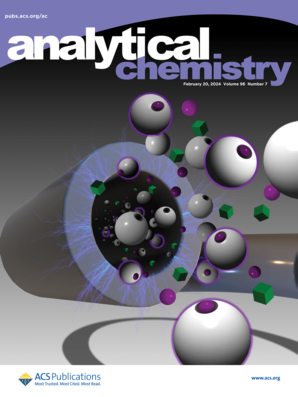具有增强磷酸酯水解酶和氧化酶样活性的分层大孔Ce-MOF纳米酶用于现场丙诺福的自级联比色检测。
IF 6.7
1区 化学
Q1 CHEMISTRY, ANALYTICAL
引用次数: 0
摘要
作为一种广泛使用的有机磷农药,丙烯磷(profenofos, PFF)在生态系统中的积累及其对人体乙酰胆碱酯酶的抑制作用引起了人们对环境和健康的关注。尽管分析技术取得了进步,但目前可用的色谱和电化学分析通常涉及复杂的程序、高成本和专用设备,限制了它们在常规和现场PFF监测中的适用性。在这里,我们报告了一种新型的自级联纳米酶为基础的比色生物传感器,采用层次大孔Ce- mof (HMUiO-66(Ce)),具有整合的磷酸酯水解酶(PEH)和氧化酶(OXD)样活性。与传统的UiO-66(Ce)相比,HMUiO-66(Ce)纳米酶具有分层大通道,增强了传质和底物可及性,显著提高了级联传感性能。通过PEH-OXD级联催化,PFF水解成4-溴-2-氯苯酚,通过类似oxd的催化选择性氧化偶联,生成明显的红色产物。这种比色响应对PFF具有高度特异性,因为其他有机磷不会触发氧化还原催化的偶联,从而最大限度地减少干扰并确保高分析选择性。该比色生物传感器可与智能手机无缝集成进行现场检测,具有较宽的线性检测范围(0.1-50 μg/mL)和极低的检出限(0.068 μg/mL),超越了大多数现有的比色方法。这项工作为通过自级联原理开发高灵敏度和选择性生物传感器提供了新的见解,为环境污染物的现场筛选提供了巨大的潜力。本文章由计算机程序翻译,如有差异,请以英文原文为准。
Hierarchically Macroporous Ce-MOF Nanozyme with Enhanced Phosphoester Hydrolase- and Oxidase-like Activities for Self-Cascade Colorimetric Detection of Profenofos On-Site.
The extensive application of profenofos (PFF), a widely used organophosphorus pesticide (OP), has raised significant environmental and health concerns due to its accumulation in ecosystems and its inhibitory effects on acetylcholinesterase in humans. Despite advancements in analytical technologies, currently available chromatography and electrochemical assays often involve complex procedures, high costs, and specialized equipment, limiting their applicability for routine and on-site PFF monitoring. Here, we report a novel self-cascade nanozyme-based colorimetric biosensor employing a hierarchically macroporous Ce-MOF (HMUiO-66(Ce)) with integrated phosphoester hydrolase (PEH)- and oxidase (OXD)-like activities. The HMUiO-66(Ce) nanozyme features hierarchical macrochannels that enhance mass transfer and substrate accessibility, significantly improving its cascade sensing performance compared with conventional UiO-66(Ce). Through PEH-OXD cascade catalysis, PFF is hydrolyzed into 4-bromo-2-chlorophenol, which undergoes selective oxidative coupling via OXD-like catalysis, yielding a distinct red-colored product. This colorimetric response is highly specific to PFF, as other organophosphates do not trigger the OXD-catalyzed coupling, minimizing interference and ensuring high analytical selectivity. The colorimetric biosensor can be seamlessly integrated with a smartphone for on-site detection, exhibiting a broad linear detection range (0.1-50 μg/mL) and an impressively low detection limit (0.068 μg/mL), surpassing most existing colorimetric methods. This work provides new insights into the development of a highly sensitive and selective biosensor through the self-cascade principle, offering great potential for on-site screening of environmental pollutants.
求助全文
通过发布文献求助,成功后即可免费获取论文全文。
去求助
来源期刊

Analytical Chemistry
化学-分析化学
CiteScore
12.10
自引率
12.20%
发文量
1949
审稿时长
1.4 months
期刊介绍:
Analytical Chemistry, a peer-reviewed research journal, focuses on disseminating new and original knowledge across all branches of analytical chemistry. Fundamental articles may explore general principles of chemical measurement science and need not directly address existing or potential analytical methodology. They can be entirely theoretical or report experimental results. Contributions may cover various phases of analytical operations, including sampling, bioanalysis, electrochemistry, mass spectrometry, microscale and nanoscale systems, environmental analysis, separations, spectroscopy, chemical reactions and selectivity, instrumentation, imaging, surface analysis, and data processing. Papers discussing known analytical methods should present a significant, original application of the method, a notable improvement, or results on an important analyte.
 求助内容:
求助内容: 应助结果提醒方式:
应助结果提醒方式:


